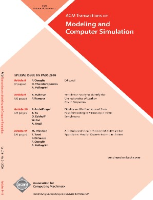
ACM Transactions on Modeling and Computer Simulation
Scope & Guideline
Unleashing Potential through Cutting-edge Computational Research.
Introduction
Aims and Scopes
- Stochastic Modeling and Simulation:
The journal extensively covers stochastic models that involve randomness and uncertainty, applying these models to areas such as queueing systems, network protocols, and optimization problems. - Simulation Optimization:
A significant focus is on methods that optimize simulation parameters and outputs, including techniques such as Bayesian optimization and Monte Carlo methods. - High-Dimensional and Complex Systems:
Research addressing high-dimensional systems, including discrete optimization and adaptive systems, is prevalent, emphasizing the need for sophisticated simulation frameworks. - Algorithm Development and Frameworks:
The journal showcases innovative algorithms and frameworks for simulation, including new computational techniques for improving efficiency and accuracy in simulations. - Interdisciplinary Applications:
The journal integrates modeling and simulation techniques across various fields such as healthcare, transportation, and cyber-physical systems, reflecting its broad applicability.
Trending and Emerging
- Reinforcement Learning in Simulation:
There is a growing emphasis on integrating reinforcement learning with simulation platforms, reflecting the increasing relevance of machine learning techniques in optimizing complex systems. - Digital Twins and Intelligent Systems:
Research on digital twins and their application in intelligent systems is on the rise, signaling a trend towards leveraging real-time data for enhanced modeling and simulation. - Bayesian Methods and Uncertainty Quantification:
Bayesian approaches are becoming more prominent, particularly in quantifying uncertainty in simulations, which is crucial for decision-making in complex environments. - Advanced Data-Driven Techniques:
The emergence of data-driven simulation techniques, including the use of neural networks and generative models, is transforming how simulations are developed and optimized. - Simulation in Emergency Management and Healthcare:
There is an increasing trend towards applying simulation methodologies in critical areas such as emergency evacuations and healthcare service operations, emphasizing their societal impact.
Declining or Waning
- Traditional Queueing Theory:
While still relevant, traditional queueing models have seen a decrease in focus as newer, more complex systems and methodologies emerge that better reflect real-world scenarios. - Basic Monte Carlo Techniques:
Basic Monte Carlo methods are gradually being overshadowed by advanced probabilistic methods and hybrid approaches that offer improved efficiency and accuracy. - Static Simulation Models:
There is a noticeable decline in the publication of static simulation models as researchers increasingly turn to dynamic and adaptive models that better capture the complexities of modern systems. - General Surveys and Reviews:
The prevalence of broad survey papers has diminished, with a shift towards more specialized, practical research that emphasizes innovative methodologies and case studies. - Classic Optimization Techniques:
Classic optimization strategies are seeing reduced emphasis as more adaptive and machine learning-based optimization methods gain traction in simulation contexts.
Similar Journals
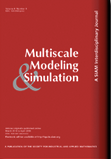
MULTISCALE MODELING & SIMULATION
Bridging scales, transforming science.MULTISCALE MODELING & SIMULATION, published by SIAM PUBLICATIONS, is a premier journal dedicated to advancing the field of multiscale modeling across various domains including chemistry, computer science, ecological modeling, and physics. With an impressive impact factor, this journal consistently ranks in the Q1 category for diverse disciplines, underscoring its outstanding contribution to the scientific community. The journal's scope encompasses innovative simulation techniques and theoretical advancements that aim to bridge the gaps between different scales of physical phenomena, making it an essential resource for researchers, professionals, and students alike. Though it does not currently offer open access, its rigorous peer-review process ensures that only the highest quality research is disseminated. Covering a dynamic range of topics from 2003 through 2024, MULTISCALE MODELING & SIMULATION remains a vital platform for interdisciplinary collaboration and exploration in the rapidly evolving landscapes of science and engineering.

Advanced Modeling and Simulation in Engineering Sciences
Driving Excellence in Engineering through Robust Simulations.Advanced Modeling and Simulation in Engineering Sciences is a premier open access journal published by SpringerNature, dedicated to advancing the field of engineering through innovative modeling and simulation techniques. Since its inception in 2014, the journal has consistently provided a platform for cutting-edge research, contributing significantly to the body of knowledge across diverse scientific domains. With a robust impact in the academic community, it ranks in the Q2 category in Applied Mathematics and Computer Science Applications and the prestigious Q1 category in Engineering (miscellaneous), reflecting its high quality and relevance. Positioned in the United Kingdom, it is accessible to a global audience, promoting open access that allows researchers, professionals, and students to freely disseminate and access crucial findings. By bridging the gap between theory and practical applications, the journal serves as an invaluable resource for those engaged in the fields of engineering, modeling, and simulation, fostering collaboration and innovation for future advancements.

SIMULATION MODELLING PRACTICE AND THEORY
Innovative Perspectives on Simulation Methodologies and Applications.SIMULATION MODELLING PRACTICE AND THEORY is a leading academic journal published by Elsevier that focuses on the dynamic and evolving fields of simulation modeling and its applications across various disciplines. Established in 2002, this journal has rapidly gained recognition within the academic community, achieving a prestigious Q1 ranking in both Hardware and Architecture, as well as Modeling and Simulation for 2023. With an impressive impact factor that reflects its significance, it offers essential insights and findings pertinent to researchers, professionals, and students alike. The journal's scope encompasses a wide array of topics, encouraging interdisciplinary collaboration and innovation. Open access options further enhance visibility and accessibility of published research, contributing to the dissemination of knowledge in this critical field. Operating from its base in Amsterdam, Netherlands, SIMULATION MODELLING PRACTICE AND THEORY continues to provide a vital platform for advancements in simulation methodologies and applications, fostering an environment where theoretical principles and practical implementation converge.

Nonlinear Engineering - Modeling and Application
Pioneering Research for a Dynamic Engineering LandscapeNonlinear Engineering - Modeling and Application is a premier journal dedicated to advancing the fields of engineering, modeling, and simulation, published by De Gruyter Poland Sp. z o.o. since 2012. With an impressive impact factor reflected in its prestigious rankings—Q2 in Chemical Engineering and Miscellaneous Engineering and Q3 in Computer Networks and Communications—this journal serves as an invaluable resource for researchers and practitioners seeking to explore the intricacies of nonlinear systems and their applications. As an Open Access journal since 2019, it ensures that groundbreaking research is readily available to the global community, fostering collaboration and innovation. Situated at the forefront of its field, Nonlinear Engineering provides high-quality, peer-reviewed articles that contribute to understanding complex phenomena in various engineering disciplines, making it an essential publication for those eager to stay on the cutting edge of technology and research.

Computation
Advancing knowledge through computational insights.Computation, published by MDPI, is an esteemed open-access journal that has been contributing to the fields of applied mathematics and computer science since its inception in 2013. With an E-ISSN of 2079-3197, this Swiss-based journal operates under a philosophy of free knowledge dissemination, allowing researchers, professionals, and students globally to access high-quality content without financial barriers. Recognized for its rigorous peer-review process, Computation is currently categorized in the Q2 and Q3 quartiles across significant domains, including Applied Mathematics (#181/635), Theoretical Computer Science (#52/130), and Modeling and Simulation (#138/324). As it converges towards 2024, the journal continues to attract innovative and impactful research aimed at advancing theoretical frameworks and practical applications within these disciplines. Joining the Computation community not only enriches individual research portfolios but also contributes to the broader conversation on computational methodologies and their applications in solving real-world problems.
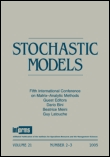
STOCHASTIC MODELS
Unraveling the complexities of stochastic phenomena.STOCHASTIC MODELS, published by Taylor & Francis Inc, is a reputable journal dedicated to the field of applied mathematics, particularly focusing on the realms of modeling and simulation, as well as statistics and probability. With an ISSN of 1532-6349 and an E-ISSN of 1532-4214, the journal has made a notable impact since its inception in 2002 and is recognized for contributing valuable research until 2024. A Q3 ranking in 2023 within the categories of Applied Mathematics and Modeling & Simulation, alongside a Q4 ranking in Statistics and Probability, underscores its significant role in advancing scholarship in these areas, despite the competitive landscape. While not an Open Access journal, it offers an array of access options to cater to its diverse readership comprised of researchers, professionals, and students. Situated in the United States, STOCHASTIC MODELS serves as a critical platform for disseminating innovative ideas, methodologies, and applications that drive forward the understanding of complex stochastic phenomena.
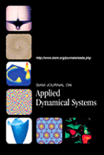
SIAM JOURNAL ON APPLIED DYNAMICAL SYSTEMS
Innovating Methodologies for Real-World Applications.SIAM Journal on Applied Dynamical Systems, published by SIAM Publications, stands as a premier platform for disseminating vital research in the fields of applied dynamical systems, analysis, and modeling and simulation. With a commendable impact factor reflecting its scholarly influence, this journal ranks in the Q1 category for both analysis and modeling/simulation in 2023, positioning it among the top resources in these disciplines. Enthusiastic researchers, professionals, and students will benefit from its rigorous peer-reviewed content that spans innovative methodologies and applications in various scientific domains. Since its inception in 2002 and continuing through 2024, the journal aims to bridge theoretical insights with practical challenges, facilitating advancements that drive progress in dynamical systems research. Contributors and readers alike can expect to engage with high-quality articles that foster meaningful dialogue, making this journal an indispensable resource for the academic community.

Computational and Mathematical Methods
Fostering Collaboration for Groundbreaking Computational ResearchComputational and Mathematical Methods is a dynamic peer-reviewed journal published by Wiley-Hindawi, focusing on innovative research in the fields of computational mathematics, mechanics, and theory. Since its transition to an Open Access format in 2022, the journal has enhanced its accessibility to researchers and practitioners globally, providing a platform for the dissemination of high-quality studies that contribute to emerging developments in mathematical modeling and computational techniques. Based in the United Kingdom, this journal is committed to fostering collaboration amongst scholars, evidenced by its rankings within Scopus: Q3 in computational mathematics, computational mechanics, and computational theory and mathematics, reflecting its relevance and influence within these critical fields. With an emphasis on interdisciplinary studies, Computational and Mathematical Methods is an essential resource for researchers, professionals, and students seeking to expand their knowledge and apply cutting-edge methodologies to practical challenges.
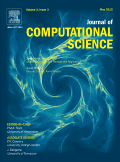
Journal of Computational Science
Unveiling New Dimensions in Computer ScienceThe Journal of Computational Science, published by Elsevier, is a premier academic journal that serves as a vital platform for researchers and professionals in the fields of computer science, modeling, and simulation. With an ISSN of 1877-7503 and an E-ISSN of 1877-7511, this journal focuses on the latest advances in computational methodologies and their applications, fostering interdisciplinary dialogue and collaboration. As of 2023, it holds an impressive Q2 ranking in multiple categories, including Computer Science (miscellaneous), Modeling and Simulation, and Theoretical Computer Science, showcasing its relevance and impact within the scholarly community. The journal features comprehensive research articles, reviews, and case studies that contribute significantly to the understanding and development of computational techniques. With its high standing in Scopus rankings, including a 79th percentile ranking in Mathematics - Modeling and Simulation, the Journal of Computational Science is an essential resource for anyone seeking to advance their knowledge and research in this dynamic field.
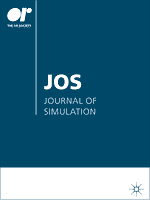
Journal of Simulation
Charting New Paths in Modeling and Engineering ExcellenceJournal of Simulation, published by Taylor & Francis Ltd, stands as a premier academic platform, addressing the intricate intersections of Industrial and Manufacturing Engineering, Management Science and Operations Research, Modeling and Simulation, and Software. With an ISSN of 1747-7778 and an E-ISSN of 1747-7786, this journal has established itself within the academic community, reinforced by its consistent ranking in the Q2 category across multiple fields as of 2023. The journal's coverage spans from 2008 to 2024, promoting innovative research and comprehensive reviews that influence industry practices and academic knowledge alike. Researchers, students, and professionals benefit from practical insights drawn from high-quality, peer-reviewed articles. Although the journal is not open access, its robust impact in the relevant fields, including a Scopus ranking placing it in the top 20% percentile in numerous categories, highlights its importance as a resource for advancing knowledge and fostering collaboration within the global simulation and modeling community.